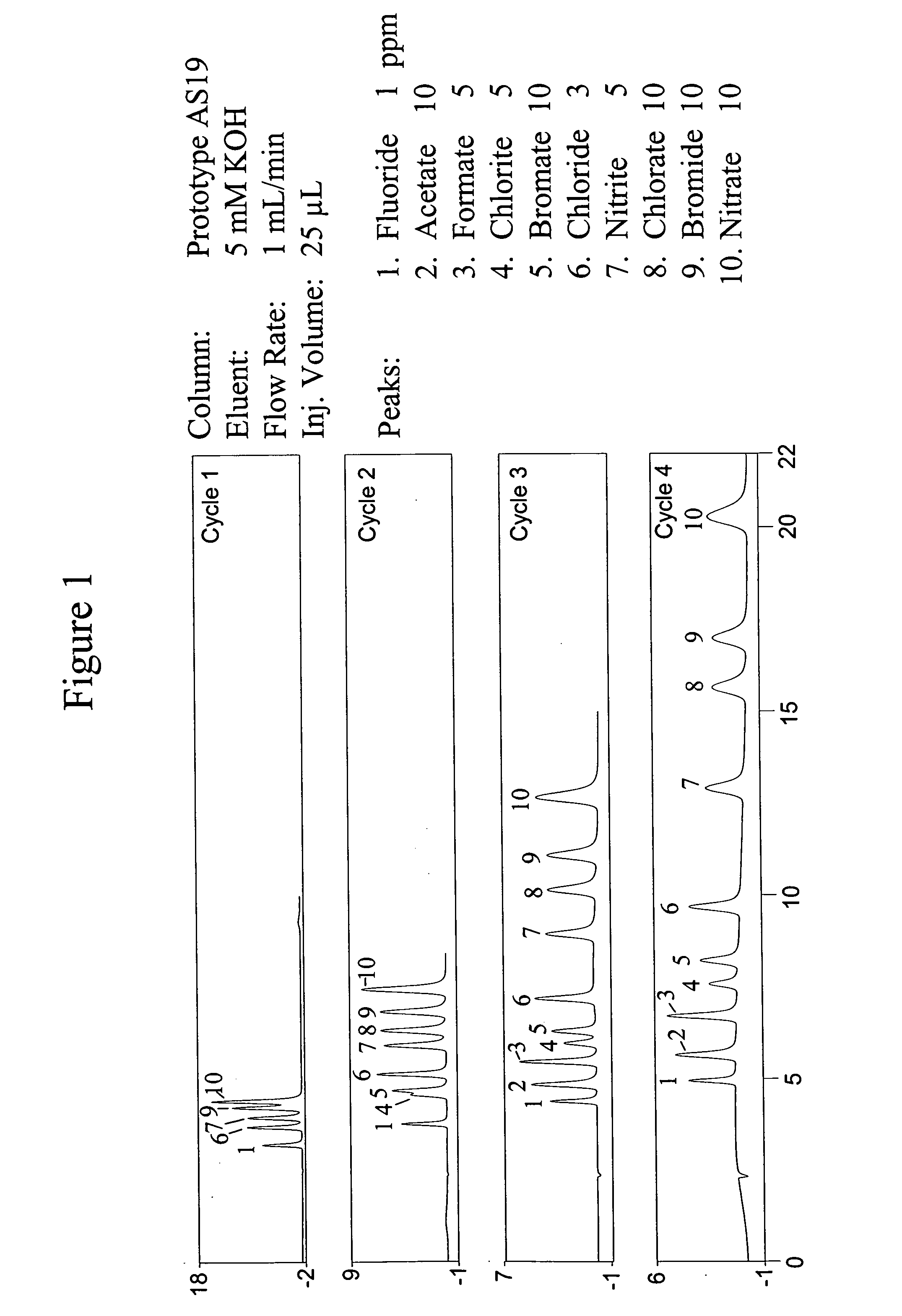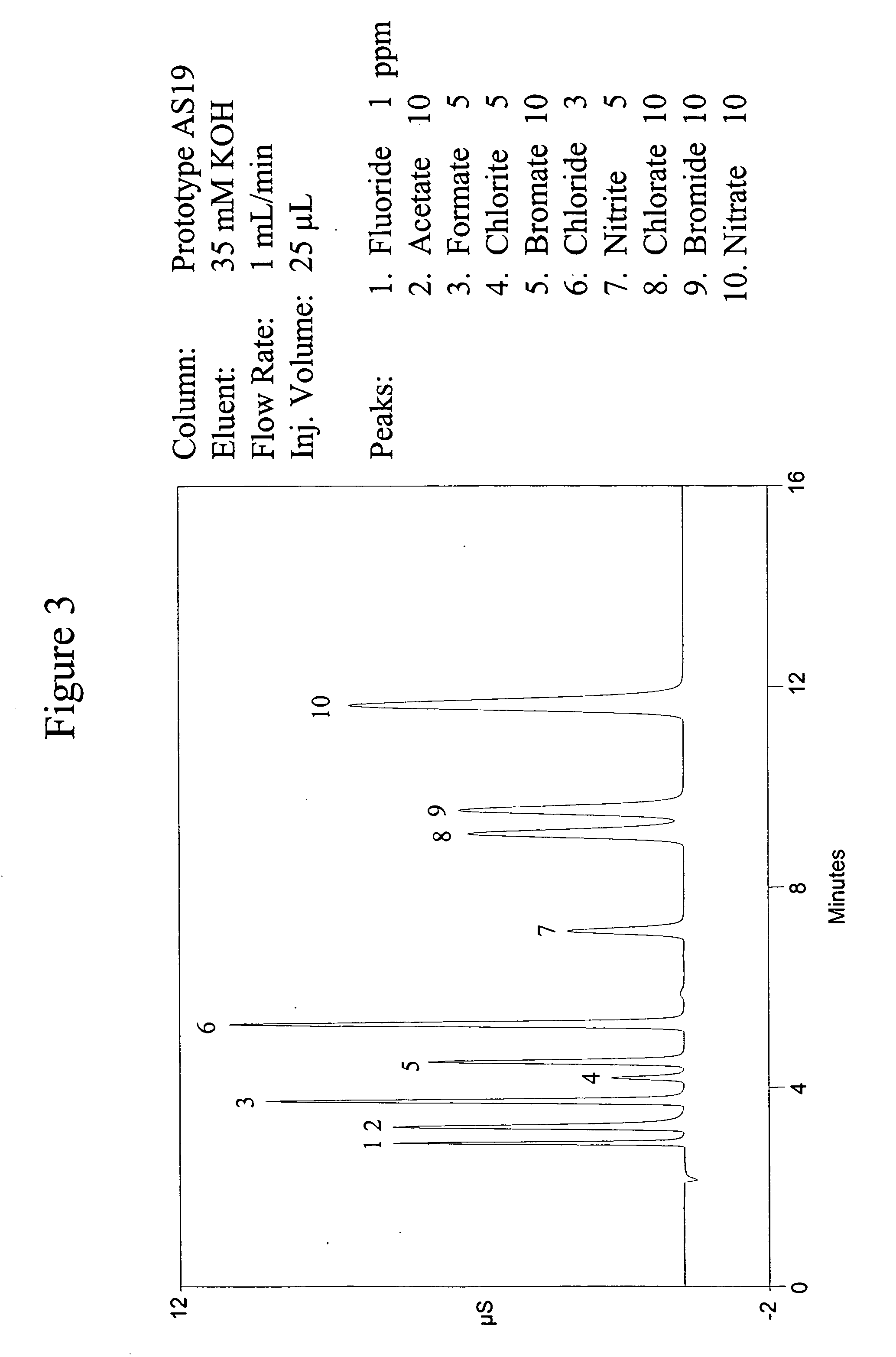Coated ion exchange substrate and method of forming
a technology of coating ion exchange and substrate, applied in the direction of amphoteric ion exchangers, natural mineral layered products, synthetic resin layered products, etc., can solve the problems of increasing manufacturing time and labor, taking a substantial period of time, and optimizing the packing column
- Summary
- Abstract
- Description
- Claims
- Application Information
AI Technical Summary
Benefits of technology
Problems solved by technology
Method used
Image
Examples
example 1
Application of All Layers In-Column
[0071] Chromatographic packing was used as the substrate to form a coated polymer according to the present invention. The process is as follows: [0072] The basement layer (first CPRP) is applied in a packed column (4×250 mm packed with 6.1 μl surface sulfonated 22 m2 / g wide-pore resin) at 0.25 m / min: [0073] Pump 7.2% 1,4-butanediol diglycidyl ether and 1.12% methylamine mixture at 60° C. water bath for 60 minutes [0074] Rinse with DI H2O for 10 minutes [0075] Each layer consists of the following reaction “cycle” at 0.25 ml / min: [0076] Pump 10% 1,4-butanediol diglycidyl ether for 10 minutes [0077] Place column for 30 minutes [0078] Rinse with DI H2O for 5 minutes [0079] Pump 4% methylamine for 10 minutes [0080] Place column in 60° C. water bath for 30 minutes [0081] Rinse with DI H2O for 5 minutes
example 2
[0082] The cycle of Example 1 was repeated one, two, three and four times to form four different selectivities in succession in the same chromatographic column. Chromatographic runs were performed using the DX500 system of Dionex Corporation with a packed chromatographic column as set forth above. The analyte mixture comprised fluoride, acetate, formate, chlorite, bromate, chloride, nitrite, chlorate, bromide and nitrate. The conditions of the runs are illustrated in FIG. 1. The results are illustrated in the chromatograms of FIG. 1 for the four different selectivity resins. FIG. 1 illustrates the utility of the stationary phase for the separation of the above-mentioned ions which include disinfectant byproduct anions. As expected, increasing the number of cycles results in an increasing column capacity. Furthermore, the separation of specific pairs of ions is enhanced by applying additional layers. Note that the resolution of chlorite and bromate are improved by increasing the numb...
example 3
Uninterrupted Preparation In-Column
[0083] In this example, an uninterrupted preparation in-column coated packing is made using somewhat different conditions as follows. [0084] The basement layer (CPRP) is applied in a packed column (4×250 mm packed with 6.1μ surface sulfonated 22 m2 / g wide-pore resin) at 0.25 ml / min and 65° C.: [0085] Pump 7.2% 1,4-butanediol diglycidyl ether and 1.12% methylamine mixture at through the column for 60 minutes [0086] Rinse with DI H2O for 2 minutes [0087] This was followed by four layers, each consisting of the following reaction “cycle” at 0.25 ml / min and 65° C.: [0088] Pump 10% 1,4-butanediol diglycidyl ether for 30 minutes [0089] Rinse with DI H2O for 2 minutes [0090] Pump 4% methylamine for 30 minutes [0091] Rinse with DI H2O for 2 minutes
[0092] This example illustrates the ability to prepare analytically useful coatings in situ. Unlike the case where the “basement layer” is applied prior to packing, the entire coating process was accomplished a...
PUM
| Property | Measurement | Unit |
|---|---|---|
| organic | aaaaa | aaaaa |
| time | aaaaa | aaaaa |
| shapes | aaaaa | aaaaa |
Abstract
Description
Claims
Application Information
 Login to View More
Login to View More - R&D
- Intellectual Property
- Life Sciences
- Materials
- Tech Scout
- Unparalleled Data Quality
- Higher Quality Content
- 60% Fewer Hallucinations
Browse by: Latest US Patents, China's latest patents, Technical Efficacy Thesaurus, Application Domain, Technology Topic, Popular Technical Reports.
© 2025 PatSnap. All rights reserved.Legal|Privacy policy|Modern Slavery Act Transparency Statement|Sitemap|About US| Contact US: help@patsnap.com



